The legendary Valery Chkalov
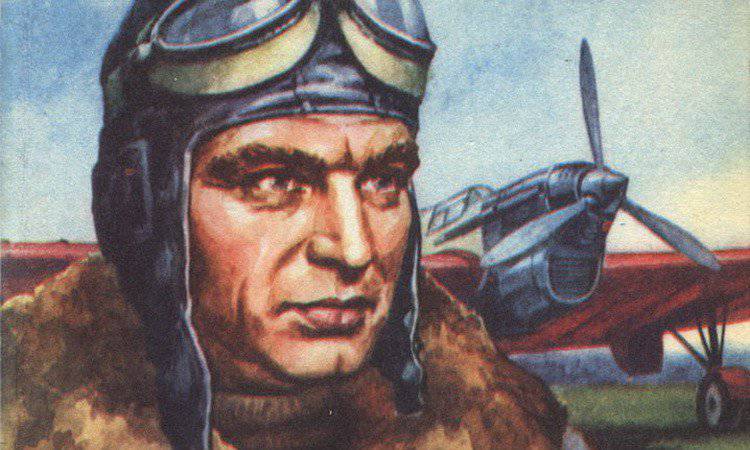
Valery Chkalov was born on the banks of the Volga in the village of Vasilev, seventy-five kilometers from Nizhny Novgorod. The whole life of the fellow villagers and his family was connected with the great Russian river. His great-grandfather and grandfather were barge haulers and hauling a line barge, his father was a Sormovsky worker, and then a boiler-maker of Vasilevsky backwater.
In 1918, a strong young guy Valery Chkalov went to work as a fireman on the Volga ships. But then he dreamed of the vast expanses of the sky. In 1919, Valery voluntarily joined the Red Army. At first he worked on the assembly and repair of aircraft, and two years later, as a reward for good work, he was sent to aviation school.
In the summer of 1924, the young fighter pilot arrived at the 1 Red Banner Fighter Squadron. It was transformed from a detachment commanded by P.N. Nesterov. Valery Chkalov flew with a soul, bravely, bravely, and soon became a well-aimed gunman, an outstanding master of aerobatics and air combat. He was a creative, daring innovator in the flight business. And it was not by chance that the rumors about Chkalov flew in parts of the Air Force as a miracle pilot.
However, his bold flights, based on accurate calculation and impeccable piloting technique, were considered by some commanders only as a violation of entrenched rules and regulations. Once in flight, Chkalov had a miscalculation, an accident occurred, and he, as a warning to others, was demobilized from the army in 1929 year.
But Chkalov did not leave aviation. He works in the Leningrad Osoaviakhim, rolls on the low-speed "Junkers" Yu-13 wanting to fly. Willingly raises fragile gliders built by enthusiastic designers of the Leningrad aeroclub in the first flight.
In 1930, by the decision of Ya.I. Alksnisa V.P. Chkalov was returned to military aviation and appointed a test pilot at the Air Force Institute. At this time, the testers MM worked here. Gromov, A.B. Yumashev, I.F. Petrov, A.F. Anisimov, I.F. Kozlov and other first-class military pilots. Outstanding aerobatics masters Valery Chkalov and Alexander Frolovich Anisimov soon became loyal and inseparable friends. The service at the scientific research institute brought V.P. Chkalov young pilot George Baidukov. Soon a strong friendship was established between them, which was rigorously tested in test flights and in world famous long-haul flights.
The most difficult and important tasks are entrusted to the Chkalov Scientific Research Institute. He tested the I-5 aircraft in aerial "battles" with A.F. Anisimov tested the capabilities of the new Soviet fighters, patiently identified the causes of flight accidents during the landing of the P-1 intelligence officer, tested new aerial bombs on TB-1.
In the winter of 1931 of the year, flight tests of the Link system developed by engineer V.S. Vakhmistrovym. The “Link” consisted of the TB-1 carrier aircraft and two I-4 fighters installed on the bomber planes.
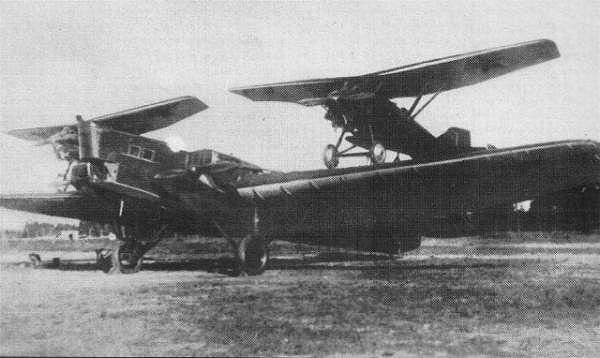
The first flight of the "shelves" (as the pilots called the brainchild of Vakhmistrov) took place on December 3 1931. The TB-1 aircraft was piloted by A.I. Zalevsky and I.F. Kozlov. The fighter mounted on the left wing was ruled by V.P. Chkalov, fighter on the right wing - A.F. Anisimov. The take-off of the "bookcase" was performed with all four working motors. At an altitude of 1000 meters, the fighters unhooked from the carrier and attached themselves to it. So build, wing to wing all the planes and landed.
Testing fighters, VP Chkalov perfected and modified many aerobatics. He worked out some figures and performed them for the first time. With full right, he is considered the author of a slow-controlled guided barrel and an ascending spin. He perfected the inverted loop of Nesterov, the exit from the inverted corkscrew and other complex maneuvers. In 1933, V.P. Chkalov becomes a test pilot at the V.R. Aviation Plant. Menzhinsky until the end of his life working with a talented aircraft designer Nikolai Nikolayevich Polikarpov. During these years, N.N. Polikarpov fighters were created TsKB-3 (I-15), TsKB-12 (I-16) and other aircraft. Test pilot Chkalov becomes a direct participant in the design and construction of new aircraft.
The prototype of the I-15 fighter was ready in October 1933. After several runs on the airfield, Chkalov lifts the I-15 into the air. After the first flight begins an extensive flight test program, refinement and improvement of design. V.P. Chkalov tests the I-15 strictly and demandingly, seeks out the hidden capabilities of the aircraft, “teaches” the new fighter to fly.
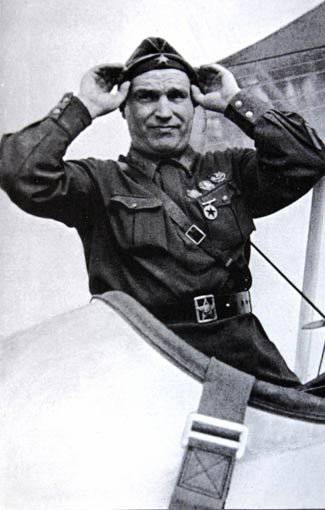
Tests continue in the winter and the wheels of the aircraft are replaced by skis. But in one of the winter flights the knot of the front shock absorber of the left ski broke, and it hung its nose down. Now, when landing, the plane will probably hook onto the ground with a ski and turn onto its back through the nose. The tester could leave the plane and escape by parachute, but Chkalov decided to land an emergency plane. At minimum speed, he led the plane to the ground and paraded on the snow. The plane almost without damage lay on his back. After a small repair, the tests were successfully completed, and the I-15 began to be mass-produced.
In 1936, N.N. Polikarpov created a new version of the I-15-bis fighter. This aircraft was also tested by V.P. Chkalov and received a ticket to mass production. Tests of the 15 have not yet been completed, and the I 16 monoplane fighter has been withdrawn from the gates of the pilot workshop at the airfield. On the last day of December 1933, the VP Chkalov raised a red I-16 in the first flight. In one of the flights on the I-16, the left leg of the chassis did not fall into place. The test pilot decided to release the emergency leg under the influence of overloads. For this, he performed with a maximum overload a whole cascade of aerobatic figures. Only after a sharp withdrawal of the plane from a steep dive, the left foot came out and fell into place. A tired but satisfied Valery Pavlovich gently landed the plane on the Central airfield. On the recommendation of V.P. Chkalov, supported by Sergo Ordzhonikidze, N.N. Polikarpov completely redid the system of production and cleaning of the chassis.
Tests of the aircraft were nearing completion when some experts began to argue that the 16 could not get out of the corkscrew. V.P. Chkalov was sure of the high flying qualities of the fighter and insisted on conducting additional tests on a corkscrew. After a beautiful take-off, Chkalov scored 2000 meters above the airfield, completed several turns of the left spin, stopped the rotation of the aircraft, and then executed several turns of the right spin. He repeated the same thing from the height of 1000 m. After getting out of the corkscrew, the pilot showed at a low altitude a cascade of aerobatic figures. The last figure ended with an impeccable landing.
With this brilliant flight, Valery Pavlovich gave a ticket to the sky to an excellent airplane. Already in February, the first serial I-1934 was released on 16, which was also tested by V.P. Chkalov. According to its tactical flight data, the 16 X-NUMX X-NUMX became the best fighter in the world. 1934 May 1936, Chkalov was among the participants in the parade at the Central Aerodrome. In conclusion of the parade, Valery Chkalov demonstrated the highest aerobatics on a new fighter with particular brilliance.
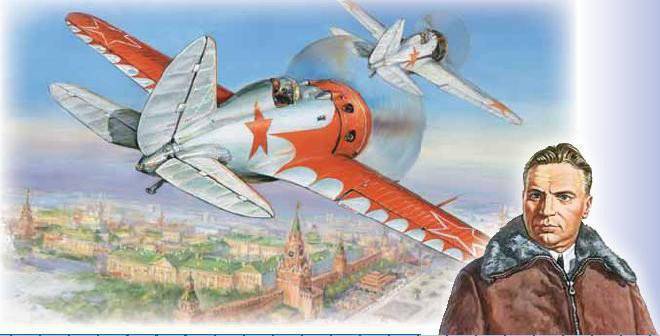
On the initiative of K.E. Voroshilov team of designers P.O. Sukhoi under the leadership of Tupolev developed a record long-range aircraft RD (ANT-25). Winter 1935 year gf Baidukov persuaded V.P. Chkalov fly on ANT-25. Valery Pavlovich tested the plane in the air, became convinced of its high flight qualities and set about trying to fly across the North Pole to America. Soon V.P. Chkalov, G.F. Baidukov and A.V. Belyakov developed a route for a flight across the pole and appealed to the Party Central Committee with a request to allow such a flight. The crew's plans were warmly supported by Sergo Ordzhonikidze. At the beginning of June, 1936, during one of the meetings in the Central Committee of the party on aviation, Ordzhonikidze reported on the preparation of the flight I.V. Stalin. After some thought, Stalin suggested the route Moscow - the Arctic Ocean - Petropavlovsk-on-Kamchatka for the flight. This route was approved.
At dawn of 20 on July 1936, the full-loaded and loaded red-winged ANT-25 froze on a hill at the beginning of the runway near Moscow airfield. A powerful motor was tested, the pads were removed, and the V.P. Chkalov begins a difficult takeoff. The first 12 hours are heavily loaded aircraft piloted by the commander. Ten hours the engine worked at maximum speed. Only over the Kola Peninsula, Valery Pavlovich slowed down the engine speed.
In the area of Victoria Island, the plane turned east, passed over the archipelago of Franz Josef Land, and headed for Northern Earth. Above Petropavlovsk-on-Kamchatka, the plane made a circle and turned in the direction of the mouth of the Amur. Over the Sea of Okhotsk, the weather has worsened, the aircraft began to freeze. The crew received a radiogram of Sergo Ordzhonikidze with the order to stop flying and sit down at the first opportunity. At this time, the plane was flying at a height of fifteen meters above the raging Sea of Okhotsk. The night darkness was approaching, when a small island Udd appeared in front, rugged by ravines and covered with numerous lakes.
On this little fit for planting a piece of sushi Chkalov and decides to plant ANT-25. Valery Pavlovich cautiously brings the plane to the ground, pulls the ravine and puts a huge plane on three pebbles at three points. After 56 hours of continuous operation, the motor stops. Chkalov, Baidukov, Belyakov descend to the ground. Looking at the safe and sound plane, stopping between large boulders, near the water-filled ravines, GF Baidukov accurately estimated the difficult landing: "Only Chkalov could have done this."
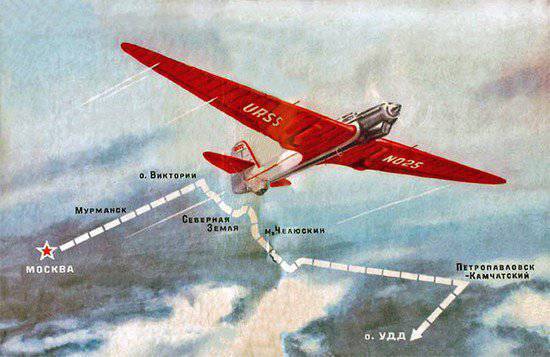
The next day, a telegram was delivered to the island, in which the government warmly congratulated the crew on the completion of the flight. And on June 24 it was reported that V.P. Chkalov, G.F. Baidukov and A. V. Belyakov were awarded the title Hero of the Soviet Union.
Soon a wooden runway, 500 meters long, was built on the island of Udd, renamed to the island of Chkalov. From this band 2 August 1936 year V.P. Chkalov took off and took ANT-25 to Moscow. 10 August at the Moscow airfield pilots met with government leaders.
21 May 1937 year expedition O. Yu. Schmidt reached the North Pole, and M.V. Vodopyanov planted the flagship on the ice. Four days later, the government allowed the crew of V. P. Chkalov to fly over the North Pole to the USA.
The start was scheduled for June 18. As in the past year, the overloaded plane began its run with a slide. At 1 the hour of 04 minutes GMT, Chkalov makes an immaculate takeoff. In 4 hours 15 minutes 19 a nurse at an altitude of 4150 meters ANT-25 passes over the North Pole. The plane is piloted by GF. Baidukov. Tired after the first hours of the flight V.P. Chkalov fell asleep. Shturman A.V. Belyakov with particular accuracy measures the height of the sun and determines the coordinates of the aircraft. After the next measurements, he informs Baidukov that the plane is flying over the North Pole. After a few minutes, Baidukov awakens Chkalov and quite seriously reports: “The summit of the world has passed. A healthy piece of the axis of your favorite "Ball" sticks out at the pole. We noticed that the axle was heavily rusted. ”
Behind the pole of relative inaccessibility, the aircraft climbs to the height of 5700 meters. "Shave on the tops of the clouds," - writes Belyakov in the logbook. Ahead on the course, the height of the clouds reaches 6500 meters. The plane enters the clouds and begins to be covered with ice. Chkalov and Baidukov decide to decline. The plane was already under the clouds, when there was a surge from the expansion tank of the engine cooling system. The water meter pin - “devil” disappeared, there was a threat of overheating and engine spell. Chkalov and Belyakov pour all drinking water and, in general, all the liquid in the cabin into a tank. Soon, "devil" appears under a glass cap. The motor is saved, Baidukov gradually increases the engine speed and sets the plane in horizontal flight mode.
Above Canada, the plane meets with cyclones and anticyclones. The height of the upper edge of the clouds reaches 5-7 kilometers. Chkalov decides to cross the Rocky Mountains and go to the Pacific Ocean. The plane is piloted by GF. Baidukov. Oxygen runs out on board. Chkalov and Belyakov give the remnants of oxygen to Baidukov. At an altitude of 6000 meters, oxygen ends, and Georgi Filippovich puts the plane into a decline. At a height of 3500 m over the Pacific Ocean, the plane leaves the clouds.
The plane is heading for San Francisco. But the weather ahead is getting worse, and the crew decides to return to Portland. In the area of Portland fog, it is raining. On the plane again bad with water in the cooling system; runs out of gas.
At altitudes below 100 meters, ANT-25 makes a circle above the Portland airfield. But Chkalov decides to land at a military airfield in Vancouver on the other side of the Columbia River. Baidukov is landing, Chkalov is helping him. Lightweight aircraft for a long time rushes above the ground, and finally its wheels gently touch the American land. The flight is over. For 63 hours 16 minutes ANT-25 passed along the route 9130 km. The distance from Moscow to Vancouver along the arc of a large circle 8582 km.
Crew V.P. Chkalov, first laid the shortest air route from Moscow across the North Pole to the United States of America.
The pilots did not even rest three hours after three days of flight, and a stream of telegrams rushed to Vancouver. Violated the American tradition and sent on Sunday a welcoming telegram to the Soviet pilots and US President F.D. Roosevelt.
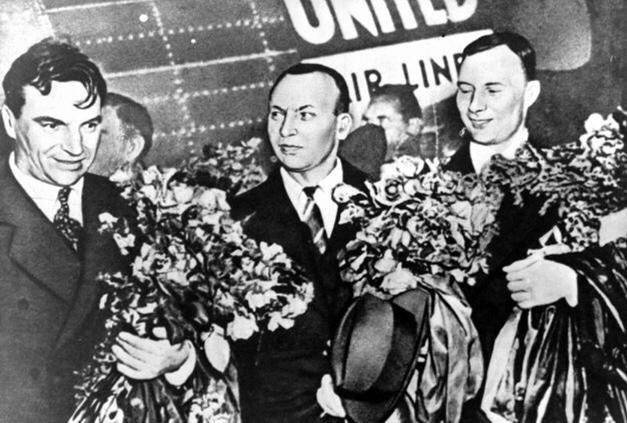
V.P. Chkalov, G.F. Baidukov and A.V. Belyakov became the most popular people in the USA. In every city where they came, they were met by thousands of crowds of ordinary Americans.
Days of stay V.P. Chkalov and his friends in America were also filled with a lot of hard work. In July, the MM crew had to fly across the pole in the USA on another ANT-25 aircraft. Gromov. Therefore, the crew V.P. Chkalov compiled a detailed report on his flight and reported to Moscow on recommendations and proposals on the schedule and route of the flight.
And at the end of July 1937, Moscow solemnly met V.P. Chkalov, G.F. Baidukova, A.V. Belyakov. After the rally on the square near the Belorussky railway station, open cars entwined with garlands of flowers and pilots headed for the Kremlin.
In 1937-1938, fascist Germany intensifies preparations for war and begins to arm its Luftwaffe with new types of aircraft. These new items are being tested in Spain. At the end of the 1937, fascist fighters Me-109Е appeared in the sky of Spain, the maximum speed of which significantly exceeds that of the I-16.
In response to this, the design team led by N.N. Polikarpov is developing a new fighter, the I-180, which has better data than the Me-109. In the creation of the 180, and the test pilot VP. Chkalov.
December Frost Day 1938 of the year V.P. Chkalov lifts the I-180 into the air. Before the end of the flight, the engine starts to give interruptions, and then stops.
The nose of the aircraft is aimed at the accumulation of wooden houses and barracks, not far from the border of the airfield. Chkalov decides to turn away from the buildings in order to save people on earth. Red-winged fighter with a three-bladed propeller stopped rapidly dropping in the direction of a wasteland. The pilot turns the plane away from the long barrack just before the ground. In this case, the plane touches the wing column and crashes into a pile of boards. From a strong blow the pilot together with the seat throws out of the plane.
So Valery Chkalov died at his post, until the end of his duty as a test pilot. Born to fly, he flew the plane until the last moment of his life, while his eyes saw his native land, and his hands held the steering wheel.
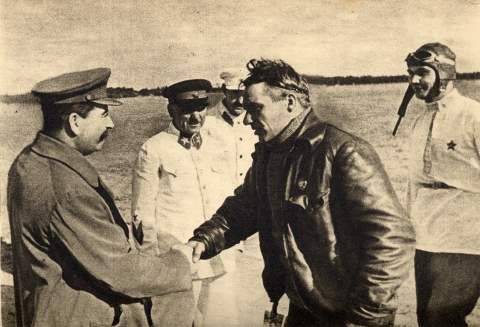
Sources:
Yu Kirilenko. Born / Yu. Kirilenko, V. Rybalko. // Wings of the Motherland: Sat. articles. - M .: DOSAAF USSR, 1983. - C.72-77.
Belyakov A. Valery Chkalov. - M .: DOSAAF USSR, 1987. - C.4-20, 43-76, 111-168.
Yakubovich N.V. Chkalov. The rise and fall of the great pilot. - M .: Eksmo, 2012. - C. 63-98, 240-251.
Information